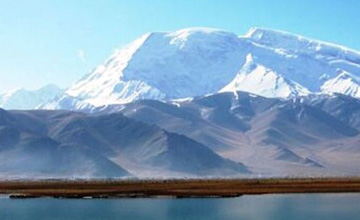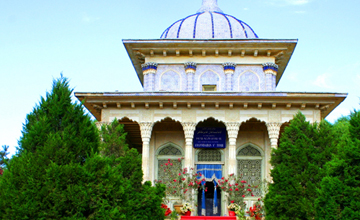Kashgar Travel Guide
You will never know the real Xinjiang if you have never been to Kashgar, this far-flung city has been an important trading centre on the ancient Silk Road and is now a multi-ethnic region.
First, we will come to Kashgar Old Town - the spirit of Kashgar; it is one of the few places that have remained immune from the passage of time, with an extraordinary cultural and architectural pattern, many travellers would gather here from all directions as if the prosperity of the ancient Silk Road reappears.
Note: Tourists can get some information from the doors of the local houses. If two doors are open, it represents that the host is at home. If only one door is open, it means only the hostess is at home. And if a curtain is hung over the front door, it means a guest is visiting this family now.
Then, we are going to visit Id Kah Mosque - a place of praying and celebrating in festivals. It is the largest mosque in China, covering 16,800 square meters. Entering this sacred place you will see the magnificent Islamic buildings, and experience the incredible religious atmosphere.
Getting out of the Old Town District, we will take you to Apakh Hoja Tomb. The Tomb is located 5 km northeast of Kashgar city; it is a typical Islamic mausoleum where Emperor Qianlong’s concubine Xiangfei ( Fragrant Concubine ) buried.
If you would like to buy some Uyghur commodities and livestock trading methods, Sunday Bazaar might be a good option.
" Bazaar " means a street where there are many small shops and stalls. Among them, Kashgar Livestock Market is the most popular sheep and cattle trading market in Xinjiang, but so far, the most prevalent were sheep and goats. People come and trade almost every day, but Sunday attracts most people, including visitors.
International Trade Market of Central and Western Asia is the best place to reflect the Uyghur customs of Xinjiang, when you travel to Kashgar Grand Bazaar, you will see the various local products such as handicrafts, articles of daily use, dry fruits, fruits and vegetables.
Say goodbye to hustle and bustle city, our final stop is Karakul Lake, lies about 200 kilometers from Kashgar City, at the foot of Mt. Muztagata. It is famous for its color-changing water, and breathtaking views are a wonderland hidden in the hills.
Spring (March to June): Tourists can go to Taxkorgan County to see apricot blossoms; they can also go to Karakul Lake and Pamir Plateau To enjoy the infinitely beautiful spring scenery.
Summer (June-September): Kashgar is hot in summer, and Karakuri Lake is a good summer resort. At this time, tasting local specialities and delicious snacks at the night market in Kashgar is also a good choice.
Autumn (September-November): Tourists can go to the Populus euphratica forest in Zepu county to enjoy the autumn and take stunning photographs.
Winter (December-February): In the cold winter, it is also quite enjoyable to taste the local roasted whole lamb.
Drive to Kashgar:
Kashgar highways extend in all directions, and all 12 counties (cities) in the district are accessible by cars. Among them, driving on the unrestricted Taklimakan Desert Highway for more than 500 kilometers is very exciting.
2. Kashgar Population: Kashgar is inhabited by the Han, Uyghur, Tajik, Hui, Kirgiz, Uzbek and other nationalities, totalling over 4,633,800 in population.
3. Packing List of Kashgar Tour: some daily necessities, Passport, camera, sunscreen products, coat, and Border Pass.
4. Border Pass of Taxkorgan, Kashgar: The Kashgar border defence detachment must handle the border crossing before travelling to Karakul ( Note: Travelers have to send us the copies of passports and visas, as well as flight or train information, hotel information, etc. at least one week in advance).
5. Kashgar Food & Specialties: Shashlicks, roast steamed buns, Roast Lamb, Naan, Badam, Jiashi melon ( kind of cantaloupe), Fig, Walnut, and Pomegranate.
6. Kashgar History: During the Eastern Han Dynasty, Kashgar was the supreme headquarters of Ban Chao for administering the Western Regions. In the Tang Dynasty, here was one of the four garrisons of Anxi. Now it is the capital of the prefecture.
What to Visit in Kashgar?
Kashgar offers beautiful landscape and historical sites, here we mapped out some well-known scenery that any foreigners travelling to the country are worth to visit. Now, let's start our Kashgar Tours.First, we will come to Kashgar Old Town - the spirit of Kashgar; it is one of the few places that have remained immune from the passage of time, with an extraordinary cultural and architectural pattern, many travellers would gather here from all directions as if the prosperity of the ancient Silk Road reappears.
Note: Tourists can get some information from the doors of the local houses. If two doors are open, it represents that the host is at home. If only one door is open, it means only the hostess is at home. And if a curtain is hung over the front door, it means a guest is visiting this family now.
Then, we are going to visit Id Kah Mosque - a place of praying and celebrating in festivals. It is the largest mosque in China, covering 16,800 square meters. Entering this sacred place you will see the magnificent Islamic buildings, and experience the incredible religious atmosphere.
Getting out of the Old Town District, we will take you to Apakh Hoja Tomb. The Tomb is located 5 km northeast of Kashgar city; it is a typical Islamic mausoleum where Emperor Qianlong’s concubine Xiangfei ( Fragrant Concubine ) buried.
If you would like to buy some Uyghur commodities and livestock trading methods, Sunday Bazaar might be a good option.
" Bazaar " means a street where there are many small shops and stalls. Among them, Kashgar Livestock Market is the most popular sheep and cattle trading market in Xinjiang, but so far, the most prevalent were sheep and goats. People come and trade almost every day, but Sunday attracts most people, including visitors.
International Trade Market of Central and Western Asia is the best place to reflect the Uyghur customs of Xinjiang, when you travel to Kashgar Grand Bazaar, you will see the various local products such as handicrafts, articles of daily use, dry fruits, fruits and vegetables.
Say goodbye to hustle and bustle city, our final stop is Karakul Lake, lies about 200 kilometers from Kashgar City, at the foot of Mt. Muztagata. It is famous for its color-changing water, and breathtaking views are a wonderland hidden in the hills.
Weather and Climate of Kashgar:
Kashgar has a warm temperate continental arid climate zone, with four distinct seasons, intensive sunshine, large annual and daily temperature changes, and little precipitation. Short warm winter and long cool summer; Spring is windy, sandstorm, and dusty weather, the average temperature 11.8 ℃ annually with the lowest of-244 ℃ and the highest of 40.1 ℃; rainfall: 61.5 mm annually. Among them, from April to October is the best time to travel to Kashgar.Spring (March to June): Tourists can go to Taxkorgan County to see apricot blossoms; they can also go to Karakul Lake and Pamir Plateau To enjoy the infinitely beautiful spring scenery.
Summer (June-September): Kashgar is hot in summer, and Karakuri Lake is a good summer resort. At this time, tasting local specialities and delicious snacks at the night market in Kashgar is also a good choice.
Autumn (September-November): Tourists can go to the Populus euphratica forest in Zepu county to enjoy the autumn and take stunning photographs.
Winter (December-February): In the cold winter, it is also quite enjoyable to taste the local roasted whole lamb.
How to Get to Kashgar?
As the crucial cities along the silk road, Kashgar has an excellent transportation industry; tourists can get there by flight, train, or car, which is quite convenient.Go to Kashgar by Air:
Kashgar Airport, 10 kilometres away from the centre of Kashgar, is the second-largest airport in Xinjiang. Currently, there are daily flights to Urumqi, Beijing, Shanghai, Chengdu, Jinan, and Pakistan.Go to Kashgar by Train:
Kashgar Railway Station is the terminus of the Southern Xinjiang Railway, located in the east of Kashgar City. You can take the train to Urumqi. It is about 6 kilometres away from the city, and it costs 10 yuan to take a taxi from the urban area.Drive to Kashgar:
Kashgar highways extend in all directions, and all 12 counties (cities) in the district are accessible by cars. Among them, driving on the unrestricted Taklimakan Desert Highway for more than 500 kilometers is very exciting.
Kashgar Travel Tips:
1. Geography of Kashgar: Kashgar is located in the middle of Eurasia, it borders Tajikistan, Afghanistan and Pakistan.2. Kashgar Population: Kashgar is inhabited by the Han, Uyghur, Tajik, Hui, Kirgiz, Uzbek and other nationalities, totalling over 4,633,800 in population.
3. Packing List of Kashgar Tour: some daily necessities, Passport, camera, sunscreen products, coat, and Border Pass.
4. Border Pass of Taxkorgan, Kashgar: The Kashgar border defence detachment must handle the border crossing before travelling to Karakul ( Note: Travelers have to send us the copies of passports and visas, as well as flight or train information, hotel information, etc. at least one week in advance).
5. Kashgar Food & Specialties: Shashlicks, roast steamed buns, Roast Lamb, Naan, Badam, Jiashi melon ( kind of cantaloupe), Fig, Walnut, and Pomegranate.
6. Kashgar History: During the Eastern Han Dynasty, Kashgar was the supreme headquarters of Ban Chao for administering the Western Regions. In the Tang Dynasty, here was one of the four garrisons of Anxi. Now it is the capital of the prefecture.





